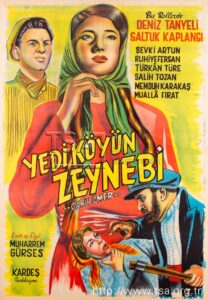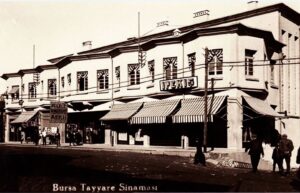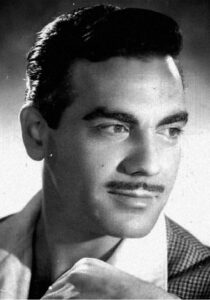1956 Malatya, Turkey

Sevgi Yenilmez
Born in 1946
Malatya, Turkey
Interviewed on February 5, 2022
by Sude Yenilmez
(Translated from Turkish)
Movies were the true highlight of my childhood. I was 10 years old when I first stepped into a movie theater. It’s been sixty-five years since then, so my memories are a bit hazy. But I distinctly remember how packed the movie theater was. Back then, my family was settled in a very small city in the eastern Turkey, Malatya. It was a relatively conservative city and the movie theater there did not allow for co-ed screenings. There would be separate matinees for men and women. One day during my winter break, my mom took me to one of the matinees for women. There I saw my first movie “Yedi Köyün Zeynebi” (Zeynep of Seven Villages).
Before I tell you more about the movie itself, let me paint you a vivid picture of the 10-year-old Sevgi sprinting to the movie theater. I couldn’t contain my excitement. Until then, the only media outlet for entertainment had been the radio for me. They would have theater shows on the radio where the actors would run their lines and try to create a world for you only by their words and voice. The idea of actually being able to put a face to those stories was so incredible that I begged my mother to take me to the movies for weeks. Back then, I didn’t know that going to the movies would be a regular experience in my life. In fact, it was all because of the romantic movies I watched growing up that I got married this early and did not finish school! (My grandmother did not finish high school and got married to my grandfather when she was only 18 years old.)
Let me also tell you that even after movie theaters became an everyday phenomenon, radio still remained important in Turkey. In the evenings, the national radio channel would broadcast the audio of the most famous movies of the week. We would record these radio shows to cassette tapes to listen later on, because we did not have the streaming services you, young people, now use to watch any movie at any time.
Going back to my first movie, it was, of course, in black and white. It was a talkie (“I am not that old!” shouted my grandmother when I asked her if the movie had audio.) But the audio did not belong to the actors themselves. There were special voice actors who would dub over them, perhaps because of their accent. So, you actually never knew the actors’ real voices. “Yedi Köyün Zeynebi” was about a woman who suffered terribly in her small, underdeveloped village. The level of violence and discrimination she faced there was truly heartbreaking. Even after the crowd started to disperse, I could still hear the women sobbing. This was the first of many movies I would leave crying.
I can’t tell you if I ate popcorn during my first movie, but I definitely remember hearing the audience eat sunflower seeds. Especially in the outdoor movie theaters that I will tell you more about, everyone would eat sunflower seeds. There would be a massive pile of seed shells on the ground at the end of every movie. Later on, people started to share popcorns especially during dates. The shy lovers’ hands would touch each other briefly during these stolen moments. (She paused for a second as she thought about my grandfather who passed away ten years ago.)
Soon after we moved to a bigger city (Bursa), going to the movies became a thrice-a-week activity. In fact, I received an offer to be in the movies when I was in 7th grade as a child actor, but given their conservative views, my father and brothers strongly opposed it. (My grandma sighed upon saying this, thinking for a second how different her life could be if they let her act.)
During my childhood, the most popular children’s movies were “Ayşecik …” series (little Ayşe). They focused on the life of a little girl named Ayşe and every movie would tell a different adventure she was on with her brother. The biggest movie theater in Bursa, “Tayyare Sineması” would host galas during the opening weekend of the movies. I remember going to a gala for an “Ayşecik” movie. The actress who played Ayşe first went on the stage and thanked everyone for being there. I was so excited and but also disappointed, because deep down, I really wanted to be like her.

Not every movie would be on every movie theater. It was almost as if every movie theater specialized in a different genre. Dilek Sineması would always show foreign movies with Sophie Lauren and Brigitte Bardot. Oh, they were so beautiful! In summer, outdoor movie theaters were very popular. They would show two movies successively. It would be so packed that if you came late, you would buy tickets for a much more expensive price from the people outside the theater. There were cheap wooden seats, and I remember the first time your grandfather took me to a movie, he put his jacket on the seat so that I would sit more comfortably.
The most popular genre was obviously romance. Ayhan Işık was the most beloved actor of the time and people would describe him as the Turkish Clark Gable – he had the same charismatic stare that every young girl fell for! In romance movies, rich girl – poor boy narrative was the most popular. The poor guy would somehow meet the girl, perhaps start working at her mansion, and they would fall in love. The cooks in those mansions played a crucial part as not only they provided the comical elements, but they were also known to give really good advice. There was not much censorship, in fact much less compared to now, that all the kissing scenes were allowed. A fun fact, however, is that when Türkan Şoray (one of the most famous actresses of the time) got married, her husband didn’t let her have any kissing scenes and I remember leaving her movies quite disappointed because of that.


I should also mention the Voice Magazine (“Ses Dergisi”), which featured a different actor every week. Its papers were such good quality that the posters of the actors looked so realistic. In every issue, there would be an interview with the actors as well as the ads for their upcoming movies. Before I forget, at the end of every movie, the ushers would go on the stage and announce the upcoming movies. We didn’t have movie trailers, but they would depict such an exciting image of the movie in their announcements that I would start begging my mom before we left the movie theater.
